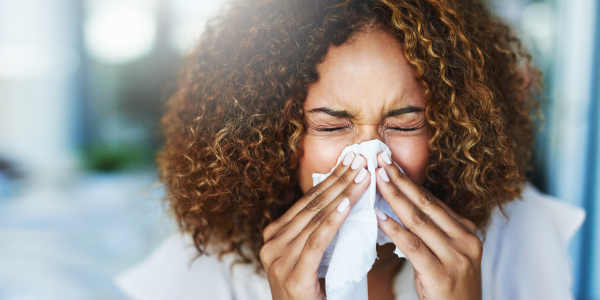In mid-August of 2021, I visited Big Bear Mountain in the San Bernardino National Forest. Once I arrived, I didn’t leave the cabin for basically a day and a half and then left a day earlier than scheduled. Not because the pristine beauty of the location was too much to handle. Unknowingly, I had traveled to Big Bear during peak ragweed season, and couldn’t stop sneezing, coughing, itching, etc. Once back in normal Los Angeles smog, my symptoms cleared and I went on with my life, vowing to check pollen counts before ever traveling again. I now always travel with extra tissues, Claritin and a wealth of knowledge about how to best deal with the bane of fall allergy season, ragweed.
What is Ragweed?
Ragweed plants are soft-stemmed weeds that grow all over the United States. There are at least 17 species of ragweed that grow in North America. The plants are most often found in rural areas and open spaces that get plenty of sunlight. Between the late spring and fall months, ragweed plants release tiny grains of pollen in order to fertilize other ragweed plants.
Depending on your location, ragweed may begin spreading its pollen in July and continue into October, typically spiking mid-September. Many people have an adverse immune response when they breathe in the pollen. In people with ragweed allergies, the immune system mistakes ragweed pollen as a dangerous substance. This causes the immune system to produce chemicals known as histamine that fight against the pollen. Histamine causes many uncomfortable symptoms such as a runny nose, sneezing, and itchy eyes. (Also, a portrait of myself in a small cabin in Big Bear.)
People who are allergic to other substances are more likely to be allergic to ragweed pollen. You’re at an increased risk for ragweed allergies if you’re also allergic to dust mites, mold, pet dander, trees or grass. And once you develop an allergy to ragweed, it’s unlikely to go away. But you can treat the symptoms through a variety of over-the-counter antihistamines and techniques to mitigate the effects of ragweed pollen.
How is a Ragweed Allergy Diagnosed?
If you think you are allergic to ragweed pollen, schedule an appointment with a board-certified allergist as soon as possible. They will conduct a prick/scratch test on your skin, placing a small amount of ragweed on your skin, which is then pierced into the skin with a needle. If you’re allergic, your skin will react and your allergist will offer a course of immunotherapy (sublingual drops under the tongue or intralymphatic shots into your lymph nodes) to best help your allergy.
Does Allergy Immunotherapy Work?
Unfortunately, immunotherapy is not an overnight fix for allergies. According to the Mayo Clinic, “Your symptoms usually improve during the first year of treatment, but the most noticeable improvement often happens during the second year. By the third year, most people are desensitized to the allergens contained in the shots — and no longer have significant allergic reactions to those substances.” Long term, this is great news. But right now, it’s not an immediate fix. So you’re probably going to need to develop some coping strategies and over-the-counter options in the meantime.
What Can I Do to Ease Ragweed Symptoms?
If you’ve made it this far and are in need of an over-the-counter remedy, ask your doctor or pharmacist for a recommendation. But take note that repeated use of some antihistamines may soften their efficacy. And with that said, here are five tips to ease ragweed symptoms during allergy season without giving up your freedom to go outside.
Pay attention to weather forecasts
Pollen counts are often included in weather forecasts, and can provide a good barometer of days when you should probably Claritin it up or pack extra tissues. Additionally, apps such as Allergy Plus provide insight into geo-targeted pollen counts and forecasts in your area. Allergy Plus will also tell you what allergens are active in your area, as well as provide you with annual allergy forecasts for a variety of allergens from ragweed to trees to grasses to chenopods.
Rain is your friend
Keep an eye on rain in the forecast. Rain is the best thing for a pollen allergy. It washes pollen out of the sky and washes away pollen on the ground. And chances are, if it rains one day, the pollen count will usually be lower than usual the next.
Clean, clean, clean
If you’re a ragweed allergy sufferer, change your clothes after coming inside, wash your hair after coming inside, and wash your hands after petting dogs or cats that have been outside. Additionally, clean the interior of your car if you drive with the windows open, and vacuum your house daily.
Identify food triggers
If you’re allergic to ragweed, your immune system likely confuses certain foods with ragweed allergens. This is called oral allergy syndrome and it includes bananas, cantaloupe, cucumber, honeydew, watermelon, white potatoes, zucchini and sunflower seeds. For a full list of foods, consult WebMD.
Get an IV Drip
Restore has specific nutrients that are designed to support allergy symptoms and fortify your immune system. Talk to your nurse so they can help you determine the best nutrients for your specific needs.






